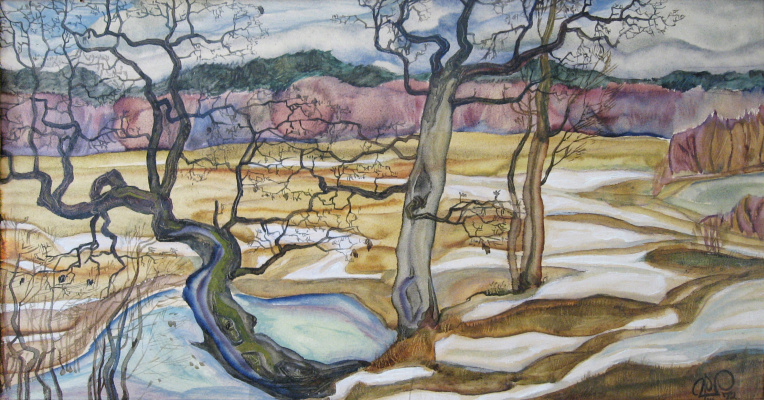log in
Enter site
Login to use Arthive functionality to the maximum
Oaks in early spring
Vladimir Vasilyevich Plastinin • Painting, 1972, 30×61 cm
Description of the artwork «Oaks in early spring»
The artist's favorite places in the vicinity of his native Vladimir ... Oaks growing in the floodplain of the Klyazma River near Lake Glubokoe became the heroes of many of his landscapes. He affectionately calls them oak, oak.
The landscape is so skillfully and gracefully executed with liquid oil on cardboard that it seems as if it was painted in watercolors.
Each tree is depicted with its own "character", which is especially evident in the clearly outlined shape of the trunks. Finely drawn small branches of oak trees resemble lace, but create a certain tension in the picture. The branches of the trees froze in bizarre movements. As if the artist had spied on some moment of their life and relationships.
It seems that a play is being played out in front of the viewer, and the trees are seen as its characters. They are like hands stretching out branches to each other and intertwined with them: maybe they are fighting, or maybe they support each other. A sense of the inherent drama is created. Or maybe they are calling out to the viewer about something? About protection? About caring? About help?
Problems of nature protection were very important for V.V. Plastinin. He not only devoted his paintings to this topic, but also wrote articles in newspapers about nature conservation more than once.
And in this landscape, the artist wants to draw the viewer's attention to those who exist nearby, wants to show that they are also alive - our neighbors on the planet. The picture was painted with great love and respect for nature.
In terms of color, the landscape is designed in a gentle and restrained range. Ice backwater, remnants of snow, dead grass - everything is harmonious. The landscape is permeated with gentle sadness akin to the sad sophistication of Art Nouveau. Let's pay attention to the time of creation of the work - 1972 - the height of the period of "stagnation". And suddenly there was such a landscape, completely inconsistent with the tasks that socialist realism posed for the artist: to optimistically show nature, transformed by man and in his service. And then the spiritualized nature with sadness about its fate ... And this shows V.V. Plastinin as an artist of completely different views, different from the dominant requirements of the official art of that period, an artist of an underground orientation.
The landscape is so skillfully and gracefully executed with liquid oil on cardboard that it seems as if it was painted in watercolors.
Each tree is depicted with its own "character", which is especially evident in the clearly outlined shape of the trunks. Finely drawn small branches of oak trees resemble lace, but create a certain tension in the picture. The branches of the trees froze in bizarre movements. As if the artist had spied on some moment of their life and relationships.
It seems that a play is being played out in front of the viewer, and the trees are seen as its characters. They are like hands stretching out branches to each other and intertwined with them: maybe they are fighting, or maybe they support each other. A sense of the inherent drama is created. Or maybe they are calling out to the viewer about something? About protection? About caring? About help?
Problems of nature protection were very important for V.V. Plastinin. He not only devoted his paintings to this topic, but also wrote articles in newspapers about nature conservation more than once.
And in this landscape, the artist wants to draw the viewer's attention to those who exist nearby, wants to show that they are also alive - our neighbors on the planet. The picture was painted with great love and respect for nature.
In terms of color, the landscape is designed in a gentle and restrained range. Ice backwater, remnants of snow, dead grass - everything is harmonious. The landscape is permeated with gentle sadness akin to the sad sophistication of Art Nouveau. Let's pay attention to the time of creation of the work - 1972 - the height of the period of "stagnation". And suddenly there was such a landscape, completely inconsistent with the tasks that socialist realism posed for the artist: to optimistically show nature, transformed by man and in his service. And then the spiritualized nature with sadness about its fate ... And this shows V.V. Plastinin as an artist of completely different views, different from the dominant requirements of the official art of that period, an artist of an underground orientation.


